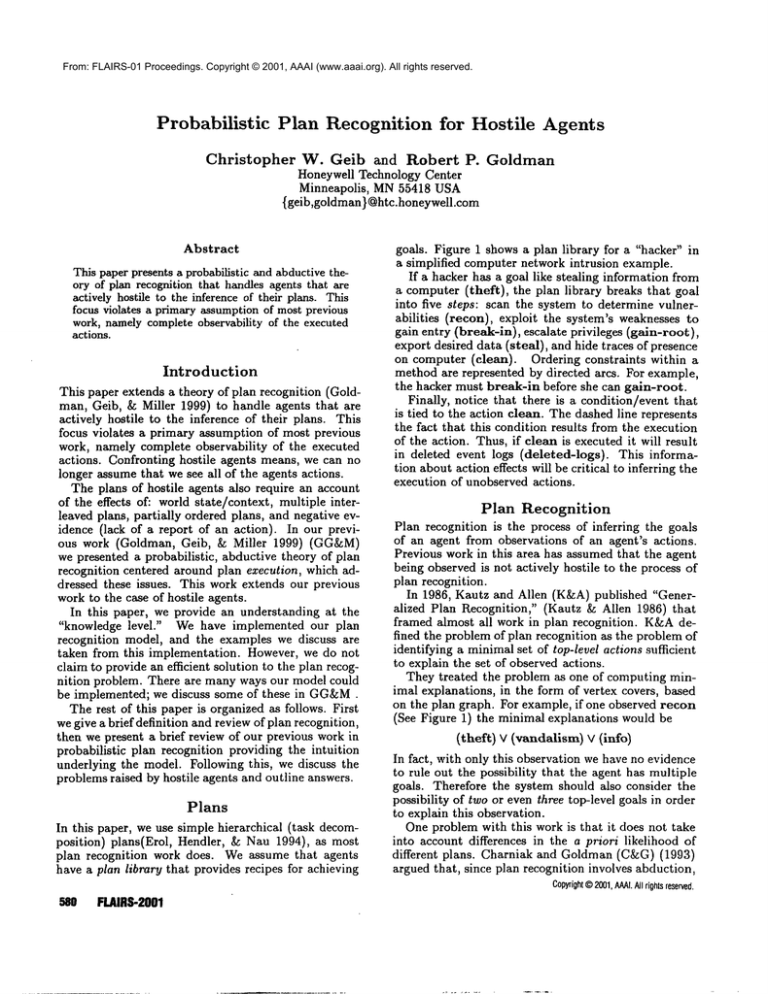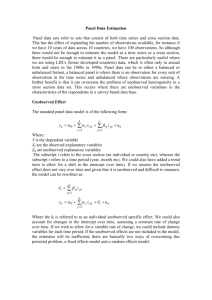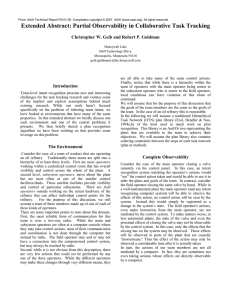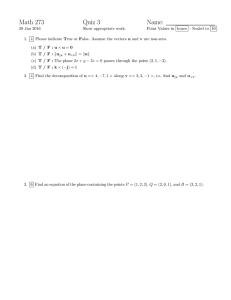
From: FLAIRS-01 Proceedings. Copyright © 2001, AAAI (www.aaai.org). All rights reserved.
Probabilistic
Christopher
Plan Recognition
W. Geib and Robert
P.
Honeywell Technology Center
Minneapolis, MN55418 USA
{geib,goldman} @htc.honeywell.com
Abstract
This paper presents a probabilistic and abductive theory of plan recognition that handles agents that are
actively hostile to the inference of their plans. This
focus violates a primary assumption of most previous
work, namely complete observability of the executed
actions.
Introduction
This paper extends a theory of plan recognition (Goldman, Geib, & Miller 1999) to handle agents that are
actively hostile to the inference of their plans. This
focus violates a primary assumption of most previous
work, namely complete observability of the executed
actions. Confronting hostile agents means, we can no
longer assume that we see all of the agents actions.
The plans of hostile agents also require an account
of the effects of: world state/context, multiple interleaved plans, partially ordered plans, and negative evidence (lack of a report of an action). In our previous work (Goldman, Geib, & Miller 1999) (GG&M)
we presented a probabilistic, abductive theory of plan
recognition centered around plan execution, which addressed these issues. This work extends our previous
work to the case of hostile agents.
In this paper, we provide an understanding at the
"knowledge level." We have implemented our plan
recognition model, and the examples we discuss are
taken from this implementation. However, we do not
claim to provide an efficient solution to the plan recognition problem. There are many ways our model could
be implemented; we discuss some of these in GG&M
.
The rest of this paper is organized as follows. First
we give a brief definition and review of plan recognition,
then we present a brief review of our previous work in
probabilistic plan recognition providing the intuition
underlying the model. Following this, we discuss the
problems raised by hostile agents and outline answers.
Plans
In this paper, we use simple hierarchical (task decomposition) plans(Erol, Hendler, ~ Nau 1994), as most
plan recognition work does. We assume that agents
have a plan library that provides recipes for achieving
58O
FLAIRS-2001
for Hostile
Agents
Goldman
goals. Figure 1 shows a plan library for a "hacker" in
a simplified computer network intrusion example.
If a hacker has a goal like stealing information from
a computer (theft), the plan library breaks that goal
into five steps: scan the system to determine ruinerabilities (recon), exploit the system’s weaknesses
gain entry (break-in), escalate privileges (gain-root),
export desired data (steal), and hide traces of presence
on computer (clean). Ordering constraints within
method are represented by directed arcs. For example,
the hacker must break-in before she can gain-root.
Finally, notice that there is a condition/event that
is tied to the action clean. The dashed line represents
the fact that this condition results from the execution
of the action. Thus, if clean is executed it will result
in deleted event logs (deleted-logs).
This information about action effects will be critical to inferring the
execution of unobserved actions.
Plan Recognition
Plan recognition is the process of inferring the goals
of an agent from observations of an agent’s actions.
Previous work in this area has assumed that the agent
being observed is not actively hostile to the process of
plan recognition.
In 1986, Kautz and Allen (K&A)published "Generalized Plan Recognition," (Kautz & Allen 1986) that
framed almost all work in plan recognition. K&Adefined the problem of plan recognition as the problem of
identifying a minimal set of top-level actions sufficient
to explain the set of observed actions.
They treated the problem as one of computing minimal explanations, in the form of vertex covers, based
on the plan graph. For example, if one observed recon
(See Figure 1) the minimal explanations would
(theft)
V (vandalism) V (info)
In fact, with only this observation we have no evidence
to rule out the possibility that the agent has multiple
goals. Therefore the system should also consider the
possibility of two or even three top-level goals in order
to explain this observation.
One problem with this work is that it does not take
into account differences in the a priori likelihood of
different plans. Charniak and Goldman (C&G)(1993)
argued that, since plan recognition involves abduction,
Copyright
©2001,
AAAI.
Allrighls
reserved.
ro
yo-wo
pa
drec
6~’--’~e~cle~n~n-r~
""~deleted- logs
"’~deleted-logs
Figure 1: A hierarchical
plan library in diagram form.
Figure 2: Generation of pending sets.
it could best be done as probabilistic (Bayesian) inference. Bayesian inference supports the preference for
minimal explanations, in the case of hypotheses that
are equally likely, but also correctly handles explanations of the same complexity but different likelihoods.
Recognition
based on execution
The plan recognition framework developed in GG&M
is based on the realization that plans are executed dynamically and that at any given momentthe agent is
able to choose to execute any of the actions that have
been enabled by its previous actions. Thus, at any
time an agent will have a pending set of actions that
are enabled by its previous actions. The agent is free
to choose to execute any of the actions in the current
pending set.
To formalize this slightly, initially the executing
agent has a set of goals and chooses a set of plans to
execute to achieve these goals. The set of plans chosen
determines the set of pending primitive actions. As the
episode proceeds, the agent will repeatedly execute one
of the pending actions, and generate a new set of pending actions from which further actions will be chosen.
The new pending set is generated from the previous
set by removing the aztion just executed and adding
newly enabled actions. Actions become enabled when
their required predecessors are completed. This process
is illustrated in Figure 2. To provide some intuition,
the sequence of pending sets can be seen as a Markov
chain, and the addition of the action executions with
unobserved actions makes it a hidden Markov model.
To use this model to perform probabilistic plan recog-
nition, we use the observations of the agent’s actions as
an execution trace. By stepping forward through the
trace, and hypothesizing goals the agent may have, we
can generate the agent’s resulting pending sets. Once
we have reached the end of the execution trace we will
have the complete set of pending sets that are consistent with the observed actions and the sets of hypothesized goals that go with each of these sets. Once
we have this set we establish a probability distribution
over it. Wecan then determine which of the possible
goals the agent is most likely pursuing.
Notice that the observations of the agent’s actions
are used to construct the execution traces. In the case
of hostile agents, the observations will not, in general,
be a complete record of the execution trace. Instead it
will be necessary to consider execution traces containing unobserved actions.
This theory was designed to handle: partially ordered actions, overloaded actions, the effects of context, and negative evidence from not observing actions
(i.e. the dog didn’t bark). While some of these problems are partially handled by other systems, no other
system handles all of them. We refer the reader to
GG&M
for a complete discussion of this formalism.
Wewill now consider extending this formalism to the
problems presented by hostile agents.
Infering
unobserved
actions
Existing work on plan recognition has assumed complete observability of the agents actions. The central
idea behind this research is to removethis assumption.
That is, we want to infer the goals of an agent given
that the behavior of the agent is only partially observable. The rest of this paper will be organized as follows,
first we will discuss two kinds of reasoning that we can
do to infer the execution of unobserved actions: inferring unobserved actions from observed actions, and
inferring unobserved actions from state changes. We
then discuss our general algorithm for plan inference
and we will conclude with a discussion of the assumptions and limitations of the algorithm.
UNCERTAINTY 581
Inferring
unobserved
actions
observed actions
Consider the following observations:
from
(gain-root,mod-webpage)
These two observations indicate with very high probability the hacker is engaged in both stealing information from a computer and defacing a webpage. WeCan
conclude this because these actions are membersof disjoint plans, that is, no single root goal will explain both
of these actions.
However these actions are even more informative
since they are both unenabled by the observed actions.
Wedefine an unenabled action is one that is observed
without having first observed the actions the plan library specifies must come before it. In this case, the
plan library specifies that recon and break-in must
occur before galn-root or mod-webpage. Therefore,
in order to explain these two observations we must assume the execution of at least one instance of recon
and break-in each. Thus, these two actions provide
evidence of two distinct plans:
(recon,
break-in,
mod-webpage)
and
(recon, break-in, gain-root)
¯ Consider our model of plan recognition. Unenabled
actions provide more information for us to use to reconstruct the agent’s actual actions than other observations. They require that the action itself be in
the sequence, but they also provide evidence of unobserved actions. Consider generating the execution
traces needed to produce the pending sets for the last
example. Not only does this set of observations allow
us to prune out any execution sequence that doesn’t
contain a galn-root, followed sometime later by a
mod-webpage, but it also allows us to ignore any
trace that doesn’t have a recon followed by a break-in
preceding the gain-root. These unenabled actions are
very important pieces of information when attempting
to infer the plans of hostile agents.
Note that in this discussion, we have implicitly assumed the agent can perform any action without detection, howeverin practice this is not true. Someactions
are simply harder to hide the execution of than others.
For example, the probability that a person could conduct a port scan of my machine without my knowledge
is much higher than the probability that they could
successfully carry out a denial of service attack against .
it without mynoticing. In this frameworkit is trivial
to add probabilities about the likelihood of an agent
performing a specific action undetected.
Inferring
unobserved
actions
from state
changes
Most existing work on plan recognition has ignored reports of the effects of actions. Simply put, reports of
state changes are unnecessary and redundant when one
S82
FLAIRS-2001
has a complete log of the agent’s actions. However,
there are a large number of domains where the actions
of the agent cannot be observed directly. Instead indirect observation is the only possible course. In these
cases, reports of state changes, can provide evidence of
the agent’s unobserved actions.
Often, whenit is possible to prevent an observer from
seeing the performance of an action, it is not possible
to prevent the observation of the action’s effects. Consider weapons testing, while a nation might be able
to covertly build a nuclear device, testing one is hard
to hide. In our network security domain consider the
clean action; the execution of the action might be hidden, but the deleting the log files is very visible.
Reports of state changes can provide evidence of unobserved actions that have the desired effect. From
them we can infer that the action must occur before
the report of the state change. Reports of state change
can also simply provide confirming information about
a previously observed action.
Consider the following sequence of observations:
(recon,break-in,delet
ed-logs)
The report of the deleted event logs implies an unobserved clean action. Further the ordering constraints
in the plan library imply that it must fall between the
execution of break-in and the report of deleted-logs.
However,if the sequence of observations were:
(recon, break-in, clean, deleted-logs)
The report would provide no extra information since
it is consistent with the observed actions. Like acquiring evidence from unenabled actions these reports give
more information about the execution traces that are
consistent with the observation.
Gathering this information from state change reports
requires a subtle assumption. Wemust assume there is
only a single report for any given state change. Since
this approach assumes that reports indicate changes in
the state, multiple reports of the same state change
will cause the system to believe that the given proposition has changed state more than once. In our network intrusion detection domain this assumption is not
a problem. "Chattering" sensors that would produce
multiple reports of the same change can be filtered.
The use of reports of state changes along with action observations is a significant contribution to plan
recognition in its own right. Weknowof no other plan
recognition systems that makes use of reports of state
changes. However, it is particularly powerful when observing non-cooperative agents if an action’s effects are
harder to hide than the action’s execution.
The solution
The central idea behind our original plan recognition
algorithm is the production of a probability distribution over the set of all pending sets. This is generated using the observations as an execution trace of
the agent’s actions. Since each pending set represents
the results of at least one execution trace, we generated
the pending sets by stepping through observations. In
the case of cooperative agents with complete and correct observations, this is sufficient.
However, as we have pointed out, in the case of hostile agents we face a problem with the execution traces.
Wecan no longer assume that the observation stream
is complete; it no longer represents the complete execution trace. Instead, for each set of observations we
must construct the set of possible execution traces, inserting hypothesized unobserved actions to complete
them.
For easy implementation we have assumed a bound
on the number of unobserved actions. The next section discusses removing this assumption. Given a finite set of primitive actions, bounding the number of
unobserved actions provides a limit on the length and
number of execution traces that must be considered. In
the worst case we only need to consider all execution
traces whose length is equal to the maximumnumber
of unobserved actions plus the number of observed actions.
This sounds like a very large search space, however
we can prune this set of execution traces with the ordering constraints provided by the observations. Weare
only interested in execution traces consistent with the
observations, therefore if a sequence does not contain
all the observed actions or doesn’t obey the ordering
constraints imposed by the sequence or plan library it
cannot generate one of the pending sets we are interested in and therefore can be filtered from consideration. The execution traces can also be filtered to be
consistent with the unobserved actions that are implied
by unenabled actions and observed state changes.
To summarize then, we handle hostile agents by extending the observed sequence of actions with hypothesized unobserved actions consistent with both the observed actions, observed state changes, and the plan
graph to create a set of possible execution traces. Then
we follow the plan recognition algorithm as before. We
use the set of execution traces to construct the pending
sets and then the probability distribution over the sets
of hypotheses of goals and plans implicated by each of
the traces and pending sets.
Example
The following example will illustrate this algorithm at
a high level. Consider the following set of action and
state change observations with a bound of three unobserved actions.
(break-in ,deleted-logs)
Given these observations and the bound on unobservable actions, the algorithm (implemented in Poole’s
PHA(Poole 1993)) walks forward through the list
observations, adding unobserved actions as required to
build a set of consistent execution traces. To explain
the given observations requires the introduction of two
unobserved actions, one to enable the action break-in
and one to cause the state change reported in deletedlogs. The complete process results in 9 possible execution traces. The first:
(recon,break-|n,clean,deleted-iogs)
is consistent with the agent not having executed any
further unobserved actions beyond those required to
justify the observations. This trace is only consistent
with the high level goals of theft or vandalism.
There are four traces that are consistent with the
execution of a second unobserved recon action performed at various points in the sequence. These traces
are not shown here, however they would be consistent
with the goal of pursuing any two of the top level goals
concurrently.
Of the four remaining traces:
(recon,break-in,gain-root,
clean,deleted-logs}
and
(reeon,break-in,clean,deleted-logs,gain-root)
are consistent only with the goal of theft. Note the
ordering differences due to the partial ordering in the
plan library. The final two execution traces:
(recon ,break-i n,mod-webpage,clean,deleted-logs)
and
(recon,break-in,clean,deleted-logs,mod-webpage)
are consistent only with the goal of vandalism. Again,
note the ordering differences due to the partial ordering
in the plan library.
In constructing this set of possible execution traces
PHAhas already established a probability distribution
over the explanations and establishes the most likely
goal. In this case, since the number of explanations
for theft and vandalism are equal and there are no
environmental factors that would weigh in favor of one
over the other, these goals are equally likely. The conjunctive plans of theft or vandalism with info is a
muchless likely third alternative.
Assumptions
In our implementation of this algorithm we have made
two assumptions about the observation stream: 1)
There is a fixed and known upper bound on the number of unobserved actions, and 2) the given observations are true and correctly ordered. Neither of these
assumptions is strictly necessary. Wewill consider each
of them in turn.
Bounding the number of possible unobserved actions
enables reasoning about where the agent could be in
the execution of its plans. Suppose we bound the number of unobserved actions at two, and we observe a
break-in action. This observation is not consistent
with the agent having already executed steal. Wehave
seen one action and the agent may have executed two
more unobserved. The agent can have executed a total
of three actions. Since, steal is the fourth step ill its
plan, the agent could not yet have executed it.
This bound can be removed from the algorithm in
a number of ways including: running the algorithm
UNCERTAINTY 583
multiple times with increasing bounds or replacing the
bound with a probability distribution over the number of unobserved actions and weighing the execution
traces accordingly. Wesee determining the best way
to remove this limitation as an area for future work.
Second, we assumed that the observed actions happen and in the order indicated by the sequence. Thus
if we have a sequence of three observations: recon,
break-in,
and gain-root,
we know recon happened
before break-in which happened before gain-root.
The observation sequences are not assumed to be complete, therefore we can’t conclude clean didn’t happen
between break-in and gain-root or even after gainroot. However, ordering constraints provided by the
plan library allow us to rule out somepossibilities. For
example, the ordering constraints allow us conclude
that if clean did occur unobserved it couldn’t have occurred before the break-in unless there were an earlier
unobserved break-in.
This assumption means we need not question the validity of observations. However, in environments with
hostile agents, this assumption must be questioned.
Consider a military example, if we receive a report of
troops massing at a particular location, we must first
determine the validity of the report before considering the effect this would have on our assessment of the
enemy’s goals. It is however straightforward to complicate the model by including a traditional model of
noisy observations.
Conclusions
In this paper we have extended a probabilistic
model
of plan recognition to handle hostile agents. Wehave
extended a model of plan recognition based on plan execution to enable the inference of unobserved actions
on the basis of observations of changes to the world
state and the execution of unenabled actions. These
extensions remove a major assumption of previous research in plan recognition and significantly broadens
the areas where plan recognition can be applied.
Acknowledgments
This material is based upon work supported by the
DARPACyber Panel program and the Air Force Research Laboratory under Contract No. F30602-99-C0177. Any opinions, findings and conclusions, or recommendations expressed in this material are those of
the authors and do not necessarily reflect the views of
DARPA,the U.S. Government, or the Air Force Research Laboratory. Special thanks to David Poole for
providing his Probabilistic
Horn Abduction PHAinterpreter and help and guidance on working with it.
References
Charniak, E., and Goldman, It. P. 1993. A Bayesian
model of plan recognition. Artificial
Intelligence
64(1):53-79.
S84
FLAIRS-2001
Erol, K.; Hendler, J.; and Nau, D. S. 1994. UMCP:
A sound and complete procedure for hierarchical task
network planning. In Hammond,K. J., ed., Artificial Intelligence Planning Systems: Proceedings of the
Second International Conference, 249-254. Los Altos,
CA: Morgan Kaufmann Publishers, Inc.
Goldman,It. P.; Geib, C. W.; and Miller, C. A. 1999.
A new model of plan recognition. In Proceedings of
the 1999 Conference on Uncertainty in Artificial Intelligence.
Kautz, H., and Allen, J. F. 1986. Generalized plan
recognition. In Proceedings of the Fifth National Conference on Artificial Intelligence, 32-38.
Poole, D. 1993. Logic programming, abduction and
probability: a top-down anytime algorithm for stimating prior and posterior probabilities. NewGeneration
Computing11 (3-4) :377-400.





